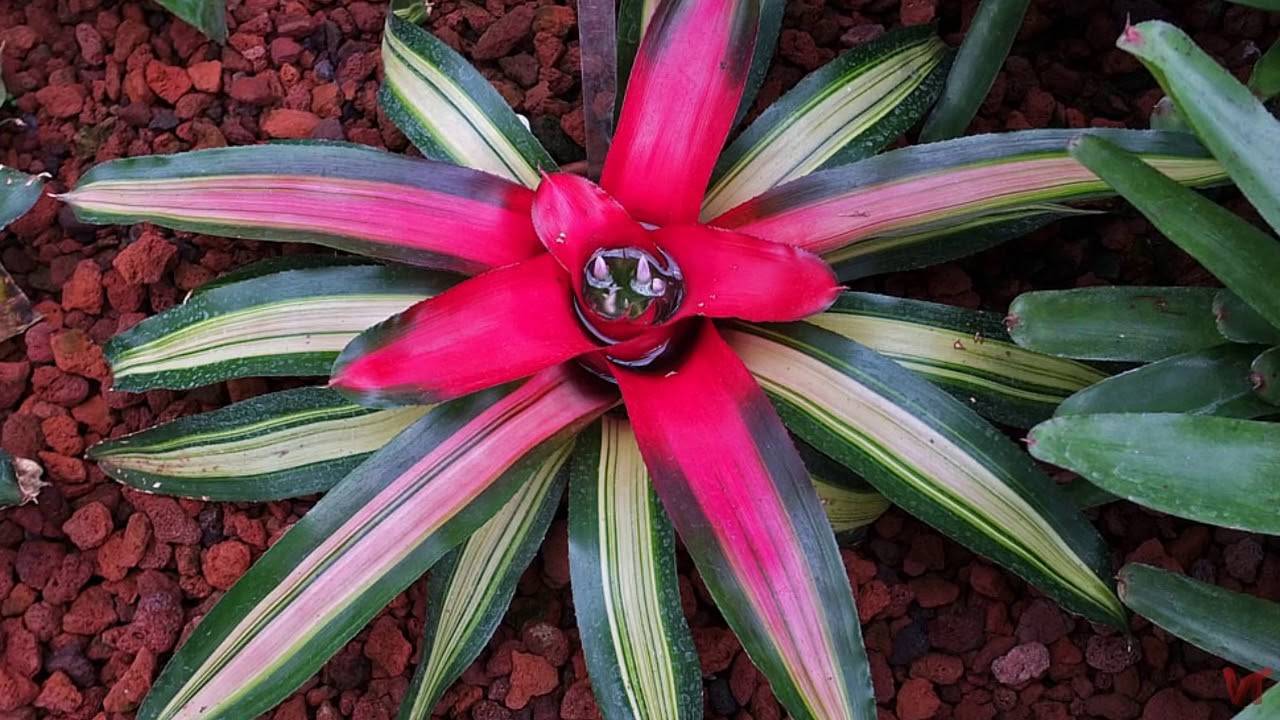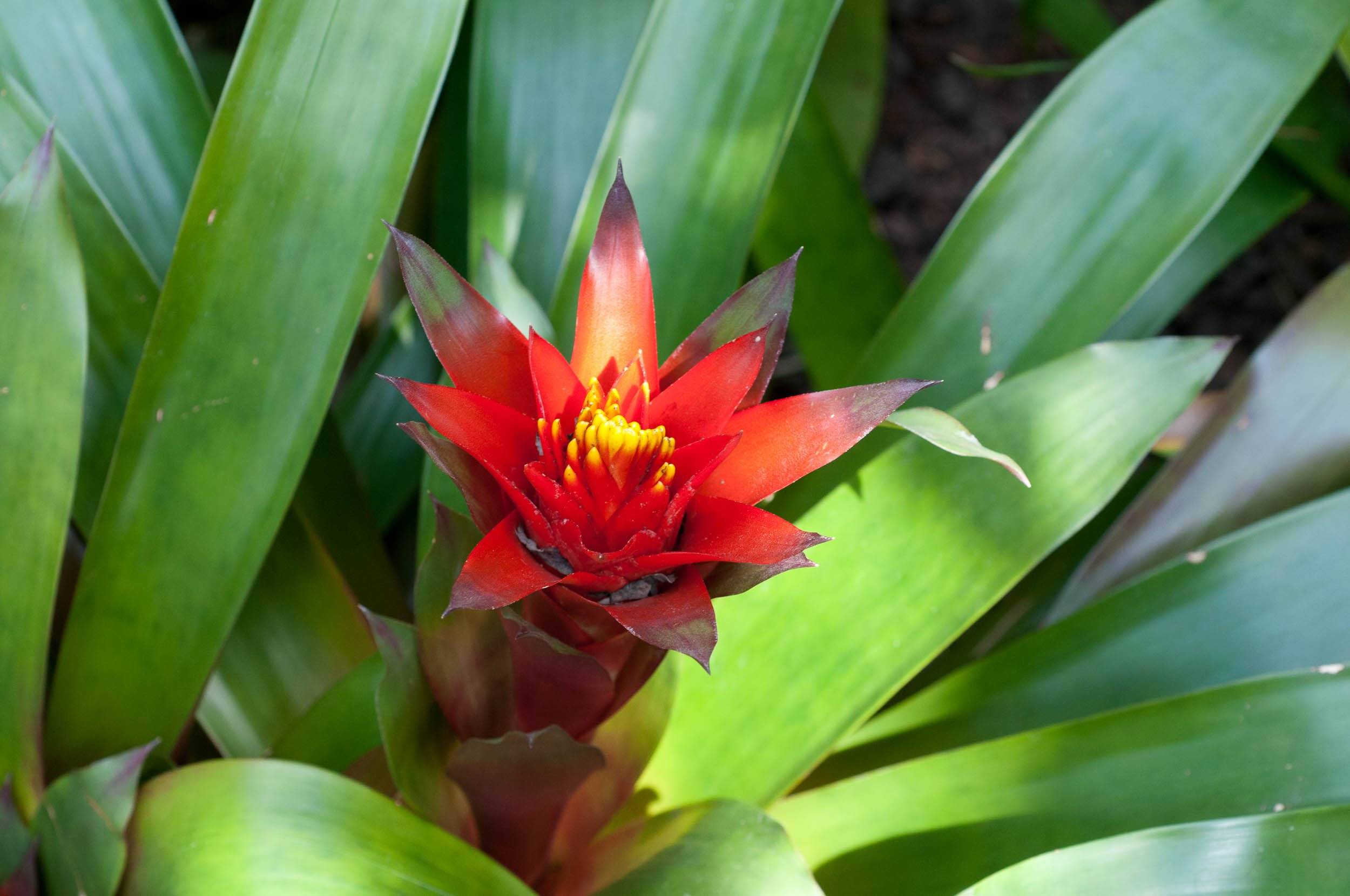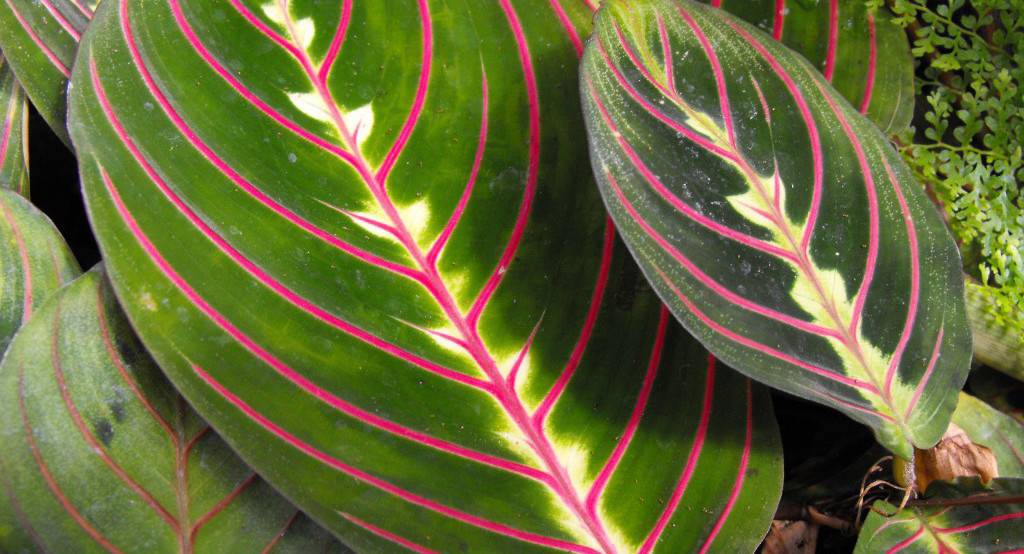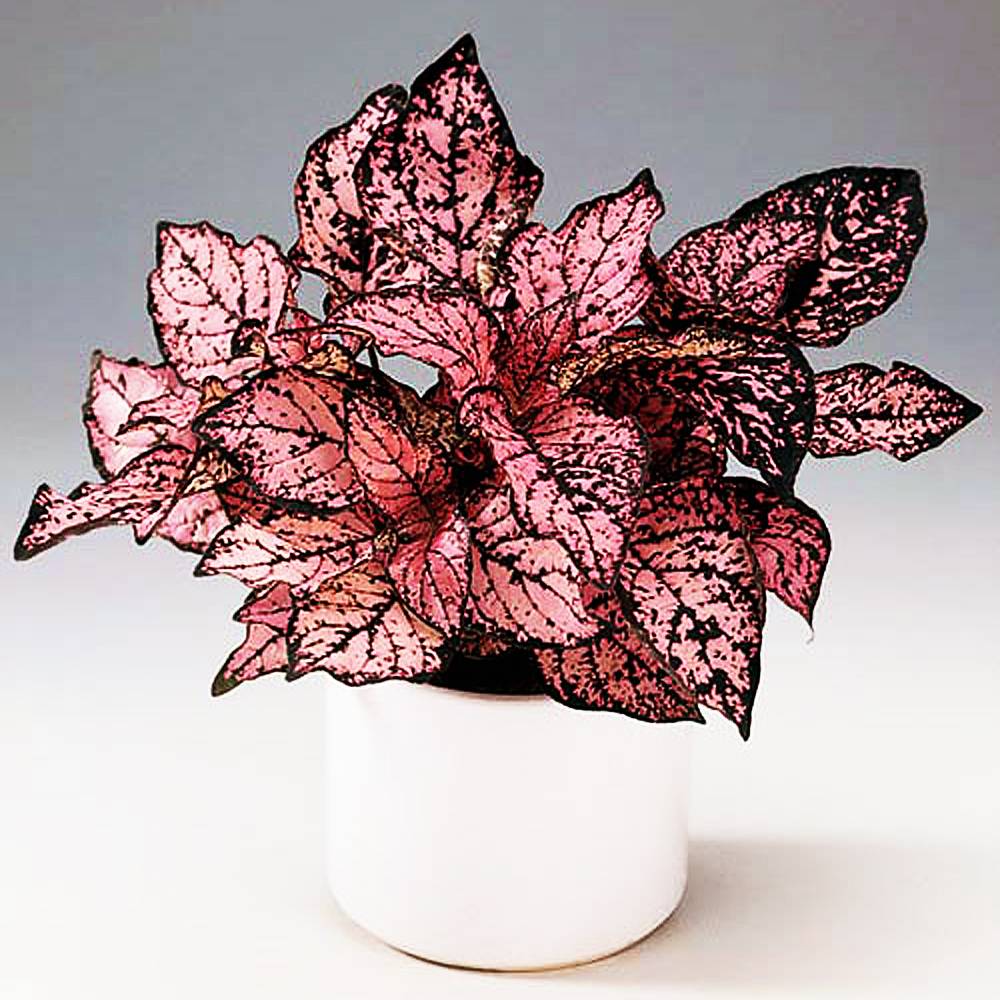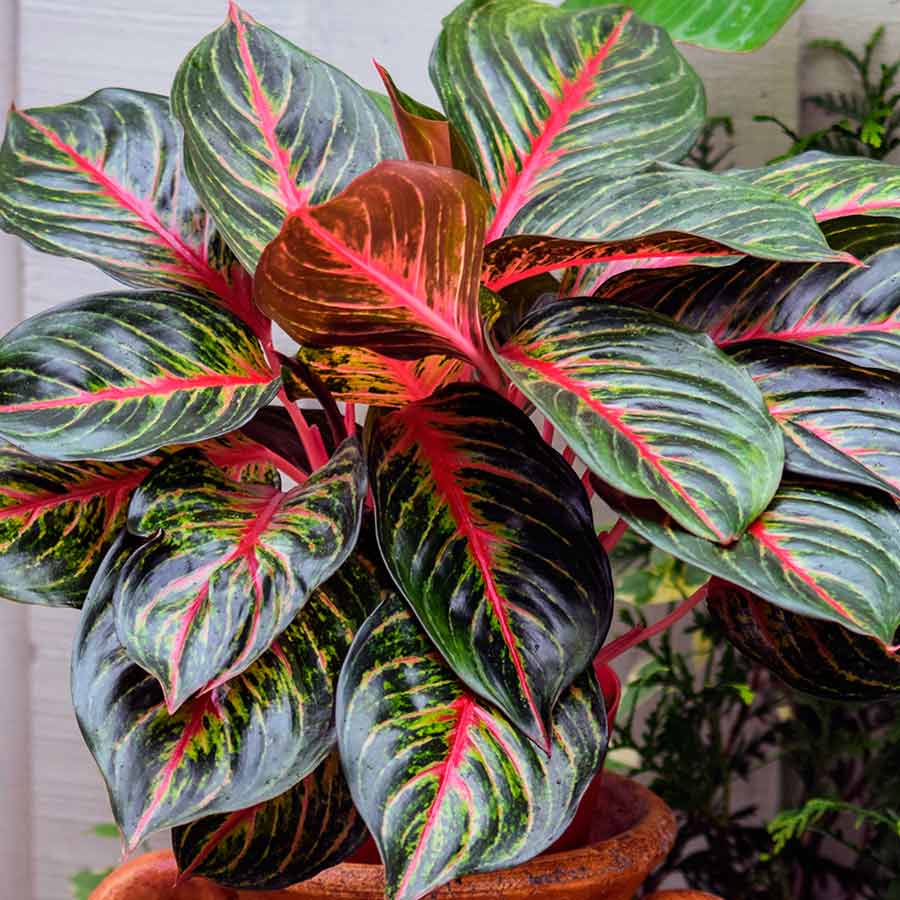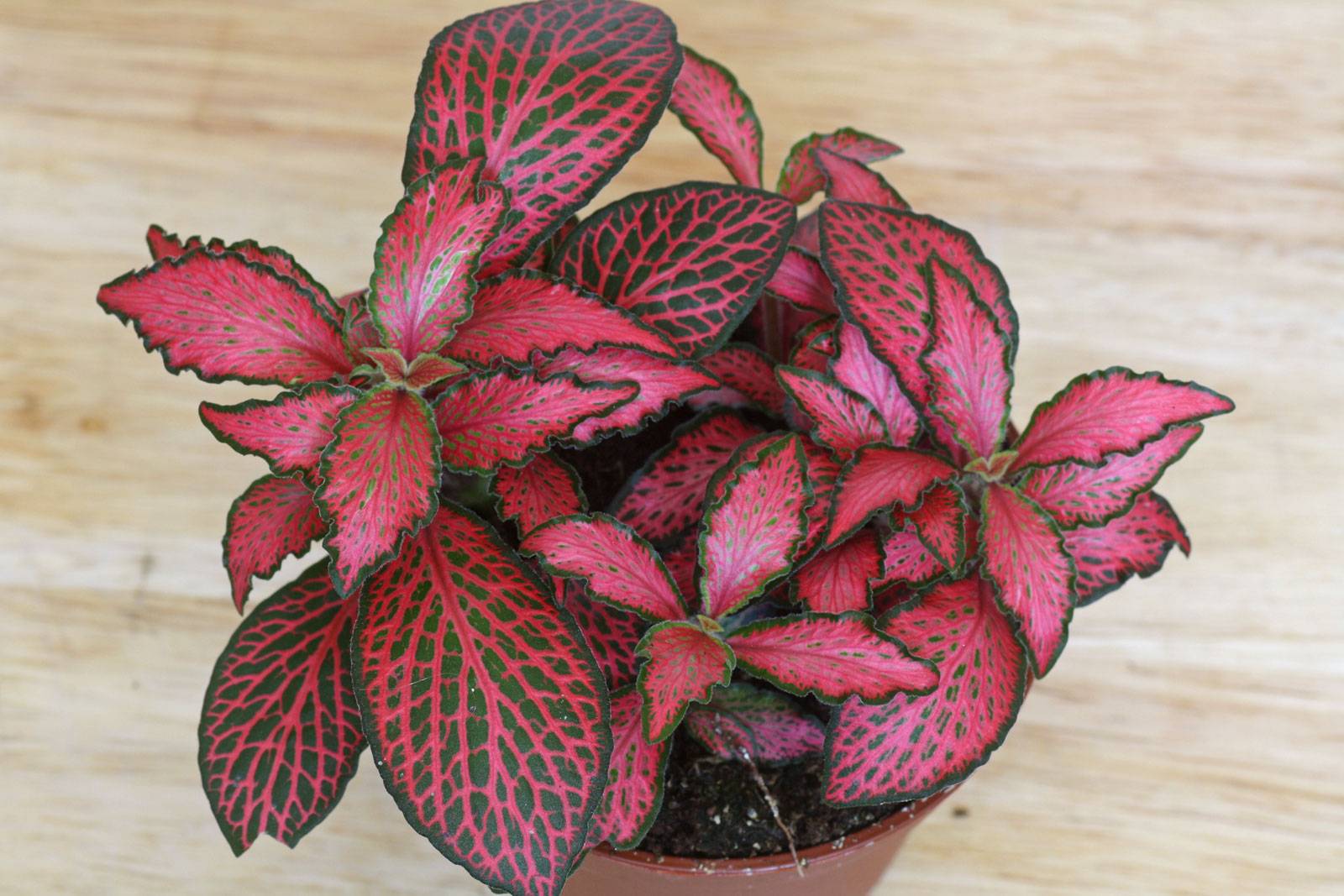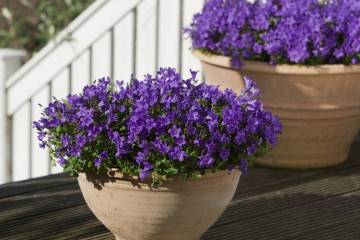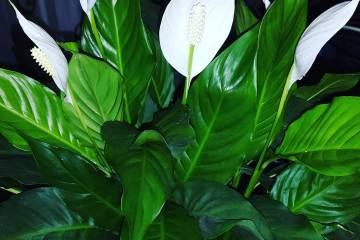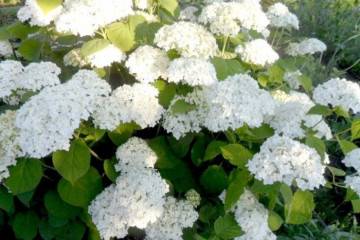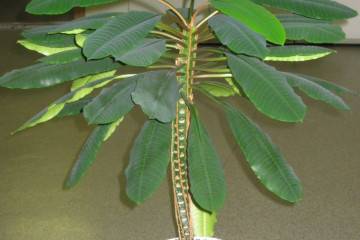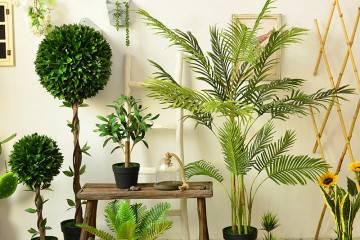What is the name of the indoor flower with red leaves
Content:
Indoor plants with red leaves come in many different types. They look beautiful and complement the interior effectively. However, house flowers with bright leaves tend to come from the tropics, so they need special care.
Names and descriptions of indoor flowers with red leaves on top
The red leaves at the top of the flower are especially impressive.
Neoregelia
A popular house plant with bright leaves is neorehelia. The flower got its name in honor of the botanist Regel. Outwardly, it is a tightly assembled rosette of thin leaves. The width is about 5 cm, the height is up to 30-40 cm.
Inorhelia is an epiphytic flower and in natural conditions it can grow on different surfaces: both in the soil and on the trunk of a tree. Therefore, homemade inorganic plants are often grown hydroponically, that is, in an aqueous composition without planting in the soil.
Poinsettia
Indoor flower with red leaves at the top is poinsettia. Scarlet leaves form a kind of bright "flower" that frames the inflorescence. The edge of the sheet can be bordered by a beige or white thin stripe. Active vegetation occurs in the cold season, flowering - at the beginning of January, so this plant is also called the "Christmas star".
The plant is a little finicky in leaving. Poinsettia loves light, but does not tolerate direct sunlight, because there is a high risk of burns. For normal vegetation, the air temperature in the room should be at least 16-17 ° C, watering is moderate.
Guzmania
In guzmania, an inflorescence has a bright color - the part framing the inflorescence. The bract is at least 5 cm long. Dense guzmania leaves form a neat rosette. The color of the leaves below is bright green. The top of the plant (inflorescence) has a bright color. The inflorescence can be red, yellow, and orange. The flowers themselves are light and inconspicuous. Flowering lasts up to 3 months.
Also, the guzmania requires periodic fertilizing with mineral fertilizers.
Description of indoor plants with red-green leaves
Plants with variegated leaves usually belong to tropical and subtropical species. The color may vary depending on conditions, the presence of light, temperature.
Houseplants with red topside leaves
The red tint of the foliage makes it feel like the plant has blossomed. However, flowers in such plants often look less colorful.
Cryptantus
In another way, cryptanthus is called the "earthen star". The plant got its name because of its star-like shape. The fleshy, leathery leaves create a dense rosette. The edge is usually carved, the end is pointed.
The color of the cryptanthus varies from pink to maroon, and vertical and horizontal stripes can also be located on the leaves.Cryptantus flowers are inconspicuous and small, usually covered with leaves. A peduncle with an inflorescence appears in the center of the rosette.
Kriptanthus is not picky about lighting, he loves light, but it also grows normally in the shade. The flower needs high humidity (daily spraying, frequent watering) and warmth. This species requires complex fertilizers several times a year.
Houseplants with a red underside of a leaf
The underside of the red leaf, although not very conspicuous, still looks attractive.
Arrowroot
The arrowroot flower is distinguished by large, wide oval leaves with red veins. On the reverse side, they are painted in red or burgundy, on the upper side - in green. But such bright leaves are located only on top of the central stems. The outer stems have green leaves. The arrowroot reaches a maximum height of 30 cm. Shoots can be erect or creeping.
For arrowroot, frequent fertilizing with mineral fertilizers is necessary, about 2 times a week. The lighting should not be bright and diffused, the humidity should be high. Frequent spraying of the foliage is recommended.
Cordilina
The houseplant Cordilina is distinguished by long leaves, the back of which is painted red. Depending on the species, the shape of the leaves of the cordilina can be xiphoid, linear or lanceolate. Also, the color varies from red to purple. There is usually a light edging along the edge. Since cordilina belongs to shrubs, its height is about 1.5 m.
For the normal existence of a flower, the air temperature must be at least 20 ° C. Cordilina does not like direct sunlight, only diffused light, but in large quantities.
Codiaum
Codiaum is a tall plant reaching 1.5 m when grown in a pot. In nature, this flower can reach 3 m. It is distinguished by wide dense leaves with a curly edge. Below the leaf is painted in a red-burgundy color, on top - in green or yellow, depending on the variety.
This indoor flower with red-green leaves requires high humidity, so it must be abundantly sprayed and watered, it is also advisable to wipe the leaves with a damp cloth for additional irrigation. If this is not done, the codiaum will "get sick", that is, it will begin to dry up and stop growing upward.
Home flowers with red spots or stripes on the leaves
Spotted and striped foliage looks bright and unusual. Such a plant will add variety to your home flower garden.
Hypestes
Hypestes is a houseplant with red-green leaves. The color of the foliage is uneven, spots. The flower has thin stems with oval leaves. The color of the plant can change depending on the lighting, with a lack of sunlight, the red spots disappear.
The flower does not like heavy soils, a mixture of compost, peat, river sand and leafy soil (1: 1: 1: 1) suits it. To maintain splendor, and the stems do not stretch too much, periodically you need to cut off the shoots that form at the crown. The normal height of the stems is considered to be a level of 30-60 cm.
Irezine
The irezine flower is distinguished by brightly colored veins: red, crimson or pink. Young leaves are green, but as they develop, they turn red or brown, the veins remain red. Due to this feature, the leaves look striped. The shape of the leaf plate is elliptical, oblong with a pointed end. Irezine is an artisanal flower, so its stems are quite dense and erect.
Irezine is demanding on water, it is better to use rainwater for irrigation.In spring, the flower requires frequent fertilizing with mineral fertilizers at weekly intervals. The dried leaves of the flower must be cut off in order to maintain their density.
Aglaonema
Aglaonema is distinguished by leathery, shiny leaves with a red vein in the center. The veins that extend from the central one create thin yellow-green stripes. Leaf shape is oblong-lanceolate, pointed. Young leaves are colored light green, with growth they darken and turn red. The average plant height is about 35 cm.
Normal vegetation occurs at low temperatures, around 20 ° C. During the period of active growth (spring-autumn), it is recommended to water about 3-4 times a week. In winter, watering is reduced, and with the onset of spring, in order to awaken the flower, you need to water it with warm water more often and feed it with mineral fertilizers.
Fittonia
Some types of Fittonia have an interesting pattern on the surface of the leaf plate, formed due to bright veins. Flower stems are thin, creeping, no more than 10 cm in height. Usually, inflorescences are formed at the top of the shoot. Fittonia flowers are of no value, because they are small and inconspicuous. The leaves of the plant are oval with a rounded end. The veins are wide, clearly visible, and bright. The length of the leaf plate is about 6-10 cm, the largest leaves are from below, and less from above.
Fittonia is very demanding on lighting. It should not be left in direct sunlight as it will get severe burns and may even dry out. The best place is the back corner of the room. For fittonia, the temperature is very important, the room should be from 20 ° C. During the period of active growth (from spring to autumn), it is watered especially abundantly; in winter, watering is reduced, but not completed.
Indoor flowers with red stems
Not only the foliage, but also the stems can be colored red, which is also quite original.
Kislitsa
Oxalis is distinguished by burgundy-purple foliage and the same bright stems. Usually the shape of the leaf is triangular, up to 4-5 cm in length. The shape of the leaf plate of the sorrel is similar to that of a clover leaf. Oxalic acid is saturated with oxalic acid salts, carotene, vitamin B, therefore it is used in some dishes as a seasoning.
The plant loves a lot of light, but leaving it in the open sun is still not worth it. It is better to place the sour pot away from the window, but not in the darkest corner. The room should be cool, up to 25 ° C, otherwise the plant will wither.
Houseplants with red foliage are guests from the tropics. Therefore, they require special conditions for good growth and abundant flowering. Before buying such a flower, they carefully study the rules for caring for it and strictly observe them in the future.

